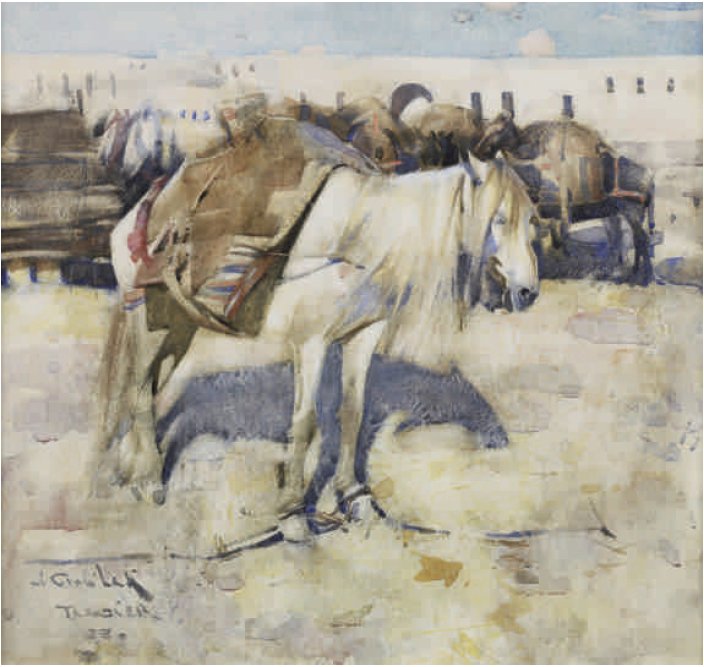
A Moorish Packhorse, Tangier. Joseph Crawhall RSW (1861-1913). Watercolour, 12½ x 13½ inches; 31.7 x 34.3 cm. Signed and dated 1888, incribed ‘Tangier’. Provenance: John Watson Esq. FRIBA, Glasgow, n.d. Exhibited: Glasgow, Scottish Society of Painters in Watercolours, 1888, no.40; Edinburgh, Bourne Fine Art, Spring Exhibition, 1996, no.17.
The Fine Art Society, London, has most generously given its permission to use information, images, and text from its catalogues in the Victorian Web, and this generosity has led to the creation of hundreds and hundreds of the site's most valuable documents on painting, drawing, sculpture, furniture, textiles, ceramics, glass, metalwork, and the people who created them. The copyright on text and images from their catalogues remains, of course, with the Fine Art Society. [GPL]
Commentary by Kenneth McConkey
The affection for Tangier is one of the more extraordinary facets of the history of Scottish art in the late nineteenth century. Painters like Joseph Crawhall were among the first to go there in 1887, following Denholm Armour, Edwin Alexander and Aubrey Hunt in 1885. Mann and Melville were there in 1890 and 1891 and they were followed in the late nineties by painters such as Robert Brough and J.D. Fergusson. After his first visit in 1891, Lavery returned in the winters of 1892 and 1893, and after 1903, for annual visits, where he established a base on the outskirts of the city.
For painters like Crawhall, attracted to Melville’s watercolours painted on his extended Middle East tour of 1880–2, Tangier was an instant Orient, appealing as much for its bustling crowds as for its striking topography (Hamilton, 45–75). In the Grand Soko, the large dusty walled market place, traders and their motley entourage of camels, mules and packhorses surrounded the painter. Occasionally the space cleared for a snake charmer, story-teller or display of Berber horsemanship. Crawhall embraced its heady atmosphere, eventually being adopted by Tangier’s expatriate community and given the nickname ‘Creeps’, by the laird of Gartmore, R.B. Cunninghame Graham. Indeed it was the adventurer laird who best captured the ease with which Crawhall displayed his talent. ‘Most artists’, he wrote:
… even those of the first rank produce their works with drops of blood wrung from the soul. ‘Creeps’, I feel sure, suffered no pangs of parturition, and I remember once when someone said all art is difficult, he answered simply, without a trace of boastfulness, but in the tone of one who states a fact, “No, not at all”. [Graham, xx]
For an artist who later gained renown for his studies of animals, this particular encounter with a Moorish packhorse, was extraordinary. Even though it was evidently a good model, the mad dog painter must work swiftly, and with complete self-assurance, in the midday sun. A slightly larger version of the same horse is in the collection of Glasgow Art Gallery, and a closely comparable work by Arthur Melville showing two horses passed through The Fine Art Society in 1994. (Gale, 1996, 61)
References
Hamilton, Vivien. Joseph Crawhall, 1861–1913, One of the Glasgow Boys. London: John Murray, 1990.
Graham, R.B. Cunninghame. ‘Creeps’ in Writ in Sand. London: William Heinemann, 1932.
Kenneth McConkey, ‘Incongruous Impressions, …’, Journal of the Scottish Society for Art History 14 (2009–10): 86 (illus.)
McConkey, Kenneth. Lavery and the Glasgow Boys. Exhibition Catalogue. Clandeboye, County Down: The Ava Gallery; Edinburgh: Bourne Fine Art; London: The Fine Art Society, 2010.
Last modified 4 October 2011